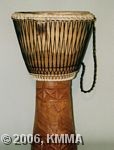


The djembe is a single-headed open goblet drum. It came originally from
Mali and Guinea and is said to be of Maninka/Susu origin. The homeland of the
Maninka is called Mande and lies roughly between Kankan (Guinea) and Bamako
(Mali). The djembe is now found all over West Africa. Initially the djembe
was a musical instrument of a griot caste who played it at cultural events
during traditional dances and historical songs and so on.
The djembe is named after the material of which the instrument is made.
The djembe used to be made from a type of wood from the djem tree, a
high-density type of wood found in Mali. Goat (be) skin is used for the
membrane, hence the name djembe.
There are three different types of djembe drum: 1) in which the base ends in a swallow's tail and the drum shell is round and vertical, 2) in which the base ends in a swallow's tail and the drum shell is funnel-shaped with a large diameter, and 3) in which the base is cylindrical and fairly narrow.
The djembe drum comes in different sizes and shapes. Usually it is around
70 to 100 cm high with a diameter of 30 cm at the top.
Traditionally the djembe is played with both hands as the drummer
stands with the drum held between his legs. It is hung over the shoulder with
a strap. In some cases the drummer sits on a stool behind the drum or the
drum is placed horizontally on the ground and the drummer sits on the drum.
Some instruments have a metal plate attached to it with small rings
that vibrate when the drum is struck, which changes the timbre of the djembe
as a result.
Different sounds are produced depending on the way the membrane is struck.
The djembe played with both hands has three basic sounds:
The djembe is played as a solo instrument and in combination with other
drums such as the djun djun.
The djembe gained a degree of popularity outside Africa around the
1950s following performances by the national troupe 'Les Ballets
Africains' from Guinea, led by Fodeba Keita. Since 1985, the djembe
enjoys international interest and has probably become the most popular
African drum ever.
© RMCA/Dominik PHYFFEROEN